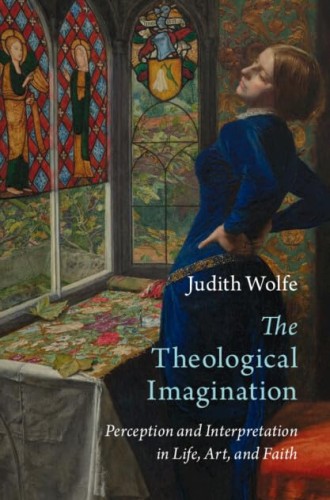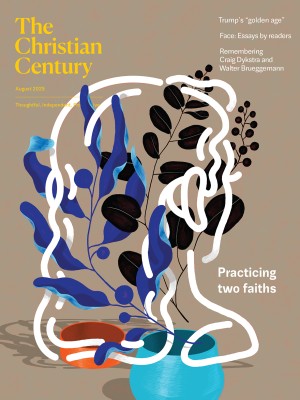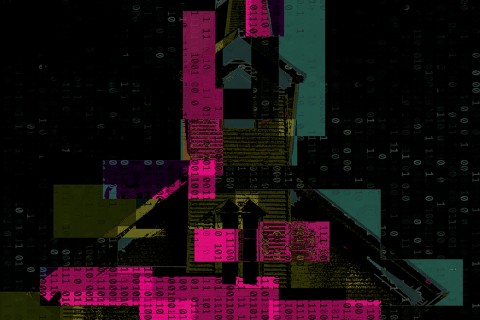Encountering art and encountering God
For theologian Judith Wolfe, imagination is a necessary part of how we know the Divine.

The Theological Imagination
Perception and Interpretation in Life, Art, and Faith
Judith Wolfe slips a photograph of Timothy Schmalz’s 2013 sculpture Homeless Jesus into the end of the third chapter of her learned, slender new book. She doesn’t comment on the image per se—she parenthetically refers the reader to it after a brief mention of Matthew 25. But the photograph may be taken as a synecdoche of her argument. Or, better, my response to it: my seeing in the photograph a sculpture, and then seeing in the sculpture the shape of a man asleep on a bench, and then seeing in that rough sleeper not only the Jesus of Matthew 25 but also of Matthew 8:20, and then connecting the image to the similar sculpture which sits in front of my own church.
My response illustrates Wolfe’s argument. Human beings characteristically see patterns and make connections. Christians ought to celebrate that faculty and receive it as part of how we find our way to God. It’s clever that Wolfe does not say much about the photo. Her taciturnity allows the reader’s imagination to perform the book.
Read our latest issue or browse back issues.
Throughout The Theological Imagination, Wolfe draws analogies between people’s encounters with art and Christians’ encounters with God. The imaginative faculty that allows human beings to discover something in a painting or a concerto is the same faculty that allows us to discover God, and to discover God’s traces in the world. “Christian faith . . . brings to things in general some of the attitudes that people ordinarily bring to works of art,” she writes, “an expectation that there is something here to be found, and a willingness to participate in its utterance.” And the anxieties that sometimes beset us when looking at, say, Georges Braque’s Violin and Candlestick (Is what I think I’m seeing in the painting really there to be seen, or am I just making it up?) are analogous to anxieties we sometimes have about God—because my capacities to see patterns and depth allow me both to sense God and to respond to a painting. (And, were I a painter, they’d be the same capacities that allow me to see in a violin and a candlestick a relationship that should be painted.)
Depth vision is something that can be trained, fostered. One way to foster it is to read poetry, which specializes in seeing one thing in terms of another. As we come to see (with the aid of Bashō) snowflakes in lilies or (with the aid of Ezra Pound) human faces in petals, we develop the skill of seeing a depth of relation not just in poetry but in the flowers in our backyard. This double vision reflects not only human propensity to make—and to delight in making—connections, but also something about the created order: “In order to see metaphors, there must be a depth-structure in which they make sense.”
And such double vision is in turn reflected in Christian liturgy. “The Last Supper made into fact what can usually exist only as poetic invention,” writes Wolfe. “In identifying bread and wine with body and blood, it is what we might call a ‘literal metaphor,’ carrying something over from one form of reality to another: It is an instance of ‘seeing-as’ which, in imagining, truly finds.”
In arguing that imagination is necessarily part of how we know God, Wolfe’s interests are polemical as well as ascetical. “The question of whether we find God or merely make Him (up) when we orient ourselves to the divine is one of the defining questions of modernity,” Wolfe reminds us. She argues against two groups of antagonists: the secularists who dismiss Christians’ perceptions about God as merely an artifact of Christians’ training themselves to have such perceptions, and the Christians who try to evade that critique by arguing that there is something essential about us (the nous, the sensus divinitatis) that inalienably and almost mechanistically senses the Divine. Wolfe rejects both views, arguing that Christians’ perceptions of the Divine are not mere projection, but neither are we able to apprehend the Divine directly, by some special sense given to us for that purpose. Rather, “there may be no way of perceiving God that is insulated from the vagaries and vicissitudes of the ordinary senses, much less one that is wholly independent of the constructive work of imagination.” This seems unimpeachably right, although it should be acknowledged that it is not just Christians reacting to modernist critique but also early theologians (e.g., Anselm, Aquinas) who ground our capacity to know God in something other than imagination.
It’s a short book. I found myself hoping that Wolfe will develop elsewhere the christological implications of her argument. (Does it do something to God to be perceived by our imaginative work?) And I longed for more development of Wolfe’s brief acknowledgment that imagination’s part in Christians’ sensing God “does not mean that . . . people of faith are radically at the mercy of their experience: the tradition offers many resources for distancing oneself from one’s own perceptions.” (I think here of reading in community, of having an abbot, of adhering to rules, such as the rule of charity, for recognizing when one’s imaginative vision has gone awry.)
Still, the reader’s imaginative capacities can take Wolfe’s argument to topics she doesn’t herself develop. My own imagination turned catechetical. When I read the book, my congregation was in the process of preparing one adult for Easter baptism and 14 adults for reception or confirmation on Trinity Sunday. What kind of catechesis ought these 15 souls receive?
Perhaps the church begins to teach its catechumens to read scripture and liturgy, as well as the world, as a kind of poem. More precisely, the church teaches them that one can read poetry (scripture, liturgy, the world) well or badly. A bad reader reduces the poem to paraphrase. A bad reader turns the metaphor into a set of claims (“the morn, in russet mantle clad, / Walks o’er the dew of yon high eastern hill” means “the sun is rising”) and then leaves the poem behind. A good reader of the poem wants the poem to open out. A good reader takes what’s offered, runs with it, and never leaves it behind.
Consider the fig tree that my catechumens heard about in the gospel lesson one Sunday during Lent (Luke 13:1–9). To read the fig tree as a poem is, first, simply to take account of the instruction the text itself already gives. It’s clear that something figural is going on; the parable isn’t only a garden manual—though it might also be a garden manual. My catechumens ought to learn that the good reader would not ask what the parable “means” or “is really saying.” They might be invited to find other fig trees in the biblical canon. They might be invited to put Jesus’ fig tree alongside Sylvia Plath’s fig tree, or Louise Glück’s, and to see what comes when those three trees interact.
Similarly, the catechumen would be invited to approach the Eucharist as a poetic figure, refusing to reduce the Eucharist to any of its “meanings.” The Wolfean catechist would prefer a rich anamnesis, whereby the past bears on and transfigures the present, over a flattening account of the rite as merely memorial. They would engage “substance and accidents” or “transignification” without imagining that such frameworks say all there is to say. At my church, the catechist would connect the eucharistic table to our weekday breakfast ministry—not by reducing the Eucharist to a ministry of sharing (which would, among other things, suggest the superiority of the weekday breakfasts to the altar), but by extending the eucharistic table to the breakfast table, so that each table was informed by the other—so that each became the other, perhaps. The catechumen would begin to see that in receiving the Eucharist, they are ingesting a set of figures and being remade into a person who can do figural work in the world.






